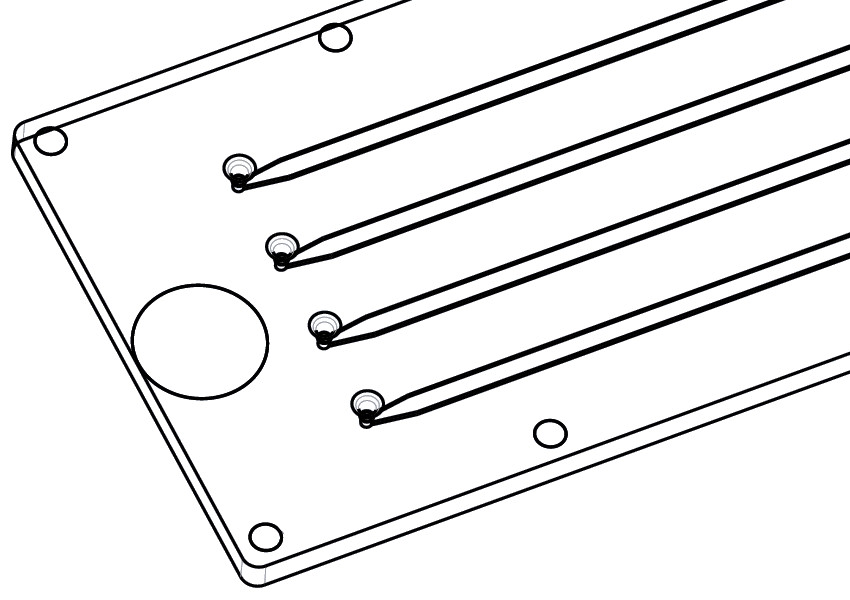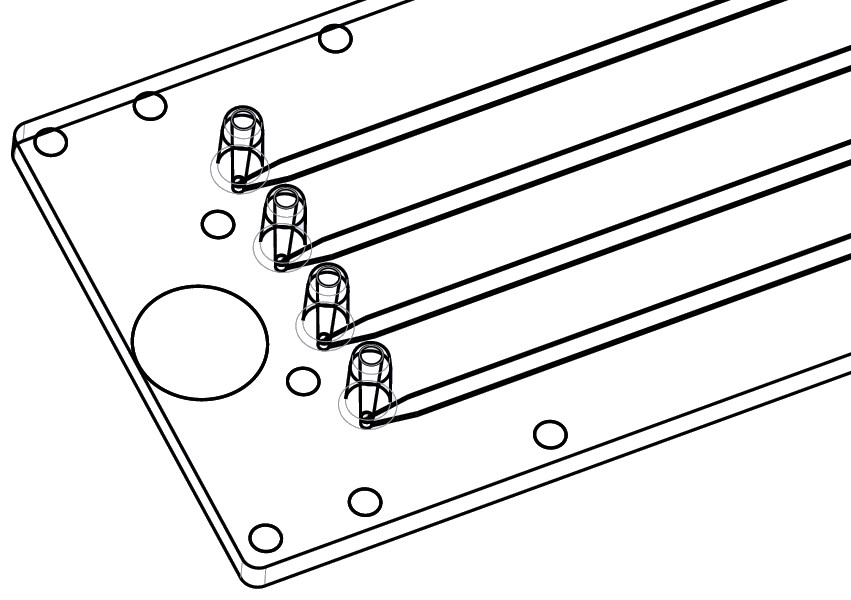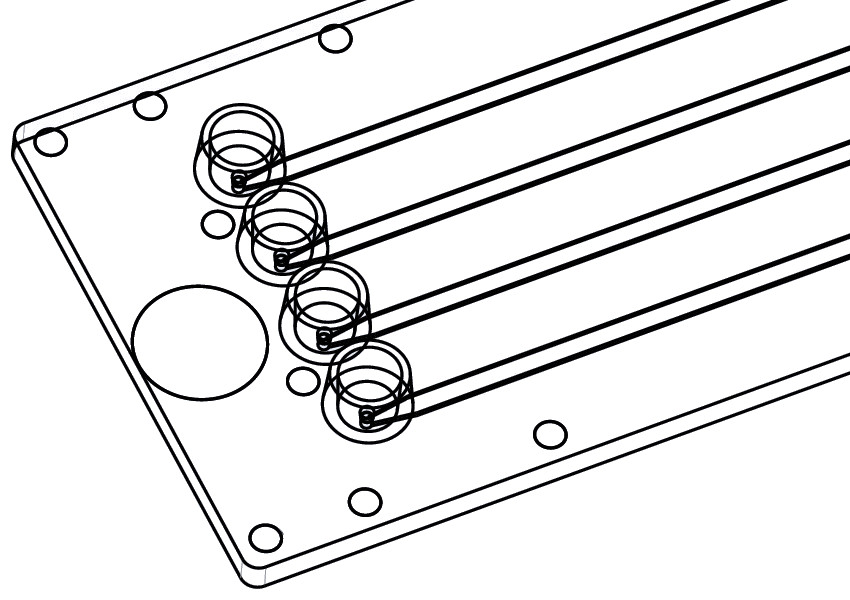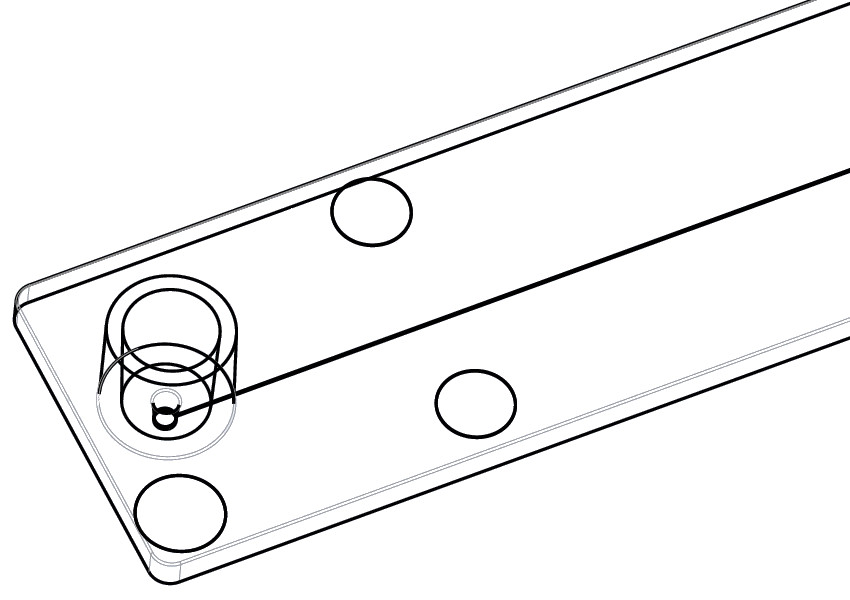The chip-to-world interface frequently remains a challenge – but we provede standard solutions and solutions optimized for microfluidic applications. This raises two questions that are promptly answered by microfluidic ChipShop‘s fluidic platforms:
What Kinds of Fluidic Interfaces can be used?
microfluidic ChipShop‘s microscopy slide formats are available with:
- Simple Through-Holes
- Olives as Tube Interfaces
- Female Luer Connectors
- Female Mini Luer Connectors
How can the Fluidic Interfaces be positioned?
- Grouped along the long side with 9 mm spacing, corresponding to the spacing of a 96-well plate
- Grouped along the long side with 4.5 mm spacing, corresponding to the spacing of a 384-well plate
- Grouped along the short side with 4.5 mm spacing, corresponding to the spacing of a 384-well plate
As highlighted above, the range of fluidic interfaces we offer for the microscopy slide format includes simple through-holes, olives, and Luer and Mini Luer interfaces. All those interfaces are spaced according to the well-spacing of a 384-well microtiter plate, e.g. with a center-center distance of 4.5 mm between them. An exception is the spacing of 9 mm between the standard Luer interfaces, which reflects the spacing of a 96-well plate in order to allow you to use pipetting robots or other automated equipment. One of our microscopy slide chip families has 16 interfaces with 4.5 mm spacing in between them at the long side. That allows you to pipette two rows of eight reagents from a microwell plate with the help a conventional eight-times multipipette.

Fluidic Interface: Through Holes
You usually use the through-hole platforms with O-rings or membranes integrated in an instrument in order to guarantee a proper sealing via press fittings. They also serve as a good interface for pipettes. One additional advantage of this interface, besides the easy application, is, that you can store the chips after use, since you can seal the interfaces with tape. That prevents contamination or evaporation. A drawback of this kind of interface is the low pressure stability on the chip-side of the connection. To adjust to that, you need a suitable counterpart on the instrument side. The standard diameter for the through-holes is 0.8 mm (top) and 0.5 mm (bottom). If you need other diameters, don’t hesitate to contact us under sales@microfluidic-chipshop.com.

Fluidic Interface: Olives
Our olive microfluidic platforms enable you to directly connect tubing to the microfluidic chips. You can, for example, use silicone tubes to connect the olives with standard PE or PTFE tubing or PEEK capillaries. You can slide the silicone tubing easily over the tapered olives, which guarantees a hermetic seal up to pressures of approximately 3 bar (42 psi). This interface is especially suited, if you want to conduct non-automated experiments, where you want to connect syringes or other external pumps to the chip. To minimize experimental variations due to the pressure-induced expansion of a longer silicone tube, you can use short sections of our silicone tubing to connect stiff tubes (e.g. PTFE, PEEK, or PE tubing) with either the chip or the pump. This interface results in a dead volume of roughly 2 μl due to the internal volume of the olives which is added to the dead volume of the tubing.

Fluidic Interface: Mini Luer
The Mini Luer microfluidic platforms combine the same advantages as their larger counterparts, the Luer platforms, only with reduced dimensions: the outer diameter is 4 mm instead of 6 mm, thus allowing us to place more interfaces on the chip. We can realize up to 16 ports along the long side of a microscopy slide. microfluidic ChipShop offers male Mini Luer plugs so that you can close the Mini Luer interfaces as well as adapter pins so that you can connect silicone tubing to these chips, which increases the versatility of the various Mini Luer platforms.

Fluidic Interface: Luer
Our Luer platforms are equipped with standard female Luer interfaces known from the medical field and are especially suited if you are working with a male Luer counterpart, which is, for example, found in conventional syringes. This allows you to manually operate the chip and directly transfer samples taken with a syringe. Furthermore, they are perfectly suited as press-fittings to connect with an instrument. microfluidic ChipShop offers Luer microfluidic platforms with either Luer interfaces on either side with a symmetrical arrangement and 9 mm spacing or five Luer interfaces on either side with a spacing of 13.5 mm and an offset of 2.5 mm from the center. The Luer interfaces ensure leak-tight connections up to pressures of several bar, enough for complex chips with comparatively high back pressures.
